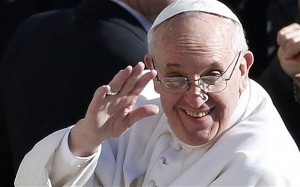The Weekly Francis is a compilation of the Holy Father’s writings, speeches, etc which I also cross-post at Jimmy Akin’s blog.
This version of The Weekly Francis covers material released in the last week from 1 September 2021 to 8 September 2021.
Angelus
General Audience
Message
Speech
Tweet
- “The pandemic has highlighted how vulnerable and interconnected everyone is. If we do not take care of one another, starting with the least, with those who are most impacted, including creation, we cannot heal the world. #SeasonOfCreation” @Pontifex, 3 September 2021
- “Taking into consideration the worsening of multiple converging political and environmental crises – hunger, the climate, nuclear arms, to name a few – the commitment to peace has never been so necessary and urgent.” @Pontifex, 4 September 2021
- “We all have ears, but very often we cannot hear. There is, in fact, an interior deafness worse than the physical one: the deafness of the heart that we can ask Jesus to touch and heal today. #GospelOfTheDay” @Pontifex, 5 September 2021
- “This is the medicine: fewer useless words and more of the Word of God. Let us hear the words of the #GospelOfTheDay addressed to us: “Ephphatha, be opened!” Jesus, I want to open myself to your Word, open myself to listen. Heal my heart.” @Pontifex, 5 September 2021
- “I assure my prayers for the people of the United States of America who have been hit by a strong hurricane in recent days. May the Lord receive the souls of the deceased and sustain those suffering from this calamity.” @Pontifex, 5 September 2021
- “May all Afghans, whether in their home country, in transit, or in host countries, live with dignity, in peace and fraternity with their neighbours. #PrayTogether” @Pontifex, 5 September 2021
- “God is gloriously and mysteriously present in creation since he is the Lord who reigns over it. To discover this, we need to be silent, listen, contemplate. #SeasonOfCreation” @Pontifex, 6 September 2021
- “Next Sunday I will travel to Budapest for the conclusion of the International Eucharistic Congress. My pilgrimage will continue for a few days in Slovakia and will conclude with the great popular celebration of Our Lady of Sorrows, Patroness of that country.” @Pontifex, 7 September 2021
- “This is the first time that @JustinWelby, Ecumenical Patriarch Bartholomew, and I feel compelled to address together the urgency of environmental sustainability, its impact on persistent poverty, and the importance of global cooperation. #SeasonofCreation messages” @Pontifex, 7 September 2021
- “Today as we celebrate the #BirthOfMary, let us ask our Mother to help us rediscover the beauty of being God’s children, overcoming differences and conflicts, to live as brothers and sisters.” @Pontifex, 8 September 2021
- “Education is one of the most effective ways of making our world and history more human. Education is above all a matter of love and responsibility handed down from one generation to another. #WorldLiteracyDay” @Pontifex, 8 September 2021
Papal Instagram








